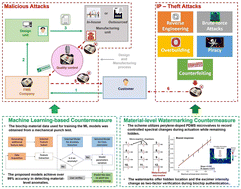Material-level countermeasures for securing microfluidic biochips†
Abstract
Flow-based microfluidic biochips (FMBs) have been rapidly commercialized and deployed in recent years for biological computing, clinical diagnostics, and point-of-care-tests (POCTs). However, outsourcing FMBs makes them susceptible to material-level attacks by malicious actors for illegitimate monetary gain. The attacks involve deliberate material degradation of an FMB's polydimethylsiloxane (PDMS) components by either doping with reactive solvents or altering the PDMS curing ratio during fabrication. Such attacks are stealthy enough to evade detection and deteriorate the FMB's function. Furthermore, material-level attacks can become prevalent in attacks based on intellectual property (IP) theft, such as counterfeiting, overbuilding, etc., which involve unscrupulous third-party manufacturers. To address this problem, we present a dynamic material-level watermarking scheme for PDMS-based FMBs with microvalves using a perylene-labeled fluorescent dye. The dyed microvalves show a unique excimer intensity peak under 405 nm laser excitation. Moreover, when pneumatically actuated, the peak shows a predetermined downward shift in intensity as a function of mechanical strain. We validated this protection scheme experimentally using fluorescence microscopy, which showed a high correlation (R2 = 0.971) between the normalized excimer intensity change and the maximum principal strain of the actuated microvalves. To detect curing ratio-based attacks, we adapted machine learning (ML) models, which were trained on the force-displacement data obtained from a mechanical punch test method. Our ML models achieved more than 99% accuracy in detecting curing ratio anomalies. These countermeasures can be used to proactively safeguard FMBs against material-level attacks in the era of global pandemics and diagnostics based on POCTs.



 Please wait while we load your content...
Please wait while we load your content...